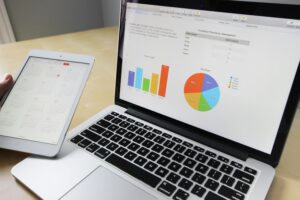In today’s data-driven world, making sense of vast amounts of information is crucial for informed decision-making. However, raw data alone can be overwhelming and difficult to interpret. This is where data visualization and reporting come into play, providing a visual representation of data that is easy to understand and act upon. Let’s delve into the importance of data visualization, explore techniques for creating effective marketing analytics reports, and discover the power of tools like Power BI.
The Importance of Data Visualization:
Data visualization is the process of presenting data in a graphical or pictorial format, such as charts, graphs, and dashboards. By transforming complex data sets into visual representations, businesses can gain valuable insights, identify trends and patterns, and communicate information more effectively. Visualizations make it easier to spot outliers, compare data points, and draw actionable conclusions, ultimately enabling better decision-making across all levels of an organization.

Creating Effective Marketing Analytics Reports:
When it comes to marketing analytics, presenting data in a clear and compelling manner is essential for driving actionable insights and informing strategic decisions. Here are some best practices for creating effective marketing analytics reports:
- Define Clear Objectives: Start by identifying the key objectives of your report and the audience it is intended for. What insights are you hoping to glean, and how will they be used to drive business outcomes?
- Choose the Right Visualizations: Select visualizations that best convey the insights you want to communicate. Bar charts, line graphs, pie charts, and heatmaps are just a few examples of common visualization types that can be used to represent different types of data.
- Keep it Simple and Relevant: Avoid cluttering your reports with unnecessary details or overly complex visualizations. Focus on highlighting the most important insights and key performance indicators (KPIs) that align with your objectives.
- Provide Context: Contextualize your data by including annotations, captions, and explanations that help interpret the visualizations and provide insights into underlying trends and patterns.
- Use Consistent Branding: Maintain consistency in branding, formatting, and design elements across all sections of your report to enhance readability and reinforce your brand identity.
The Power of Power BI:
Power BI is a powerful business analytics tool developed by Microsoft that enables users to visualize and share insights from their data in real-time. With Power BI, businesses can connect to a wide range of data sources, create interactive dashboards and reports, and collaborate with colleagues to drive data-driven decision-making. Its intuitive interface and robust features make it a popular choice for organizations looking to harness the power of data visualization and reporting.

In conclusion, data visualization and reporting play a crucial role in transforming raw data into actionable insights that drive business success. By adopting best practices for creating effective marketing analytics reports and leveraging tools like Power BI, businesses can unlock the full potential of their data and make informed decisions that propel them towards their goals.
